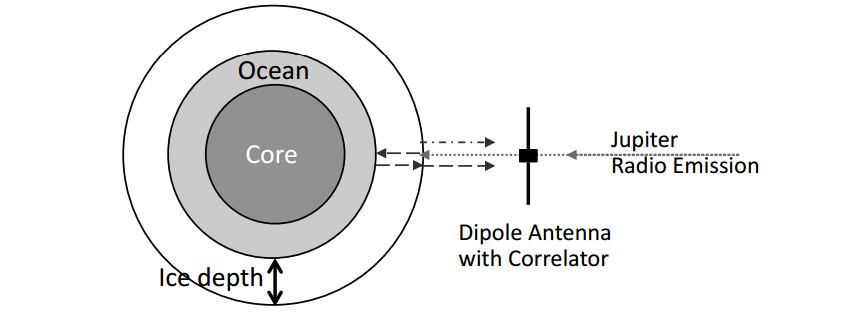Jupiter’s Radio Emissions Could Reveal the Oceans on Its Icy Moons, Say Planetary Geologists
Among the most exciting destinations in the Solar System are Jupiter’s icy moons Europa, Ganymede, and Callisto. While the surface temperature on these bodies is a cool -160 °C, astronomers believe they all hide oceans of liquid water beneath their icy surfaces. That raises the intriguing possibility that these moons have all the ingredients required for life.

So it’s no surprise that astronomers want to look more closely at these places and ultimately to visit and sample the water that lies beneath. But before that can happen, they need to measure and characterize the oceans to better understand their size, composition, and potential for life.
An important question, then, is how best to do this.
Today we get an answer of sorts thanks to the work of Andrew Romero-Wolf and pals at the Jet Propulsion Laboratory in Pasadena, California. These guys have come up with a novel way to measure the internal structure of these oceans using a kind of ground-penetrating radar system.
What’s interesting about their proposal is that it is hugely robust and relatively cheap because the radio waves will be provided by Jupiter itself, one of the noisiest radio sources in the Solar System.
Ground-penetrating radar works by beaming radio waves into the Earth and listening for reflections from the boundaries between layers and even from buried objects. Provided it is sensitive enough, this mechanism should easily be able to spot the boundaries between ice and water between water and rock.
Indeed, it has been used on various missions to better understand other planets, such as the European space agency’s Mars Express probe and the Mars Reconnaissance Orbiter built by the Jet Propulsion Laboratory.
Of course, the more powerful the radar, the greater the information it can send back. And therein lies a problem. Power is a limited resource on any space mission, particularly one to Jupiter where its distance from the sun dramatically limits the amount of solar power available.
Enter Romero-Wolf and pals. These guys point out that Jupiter itself is a powerful emitter of radio waves at precisely the tens of meter, or decameter, wavelength that is useful for ground-penetrating radar. In fact, Jupiter’s emissions at these wavelengths are some 3,000 times stronger than the galactic background. This has given them the idea for a novel approach to the problem.
Their idea is to place a probe between Jupiter and its target, Europa for example. This probe listens for radio signals generated by the planet as they head towards the moon. It then listens for any reflections from the moon’s internal structure.
Planetary geologists back on Earth can then use this information to build a detailed picture of the structure of the moon and any oceans it may hide. “An instrument located between the icy moon and Jupiter could sample the [decametric radio] emission along with its echoes reflected in the ice layer of the target moon,” they say.
The big advantage of this idea is that it is entirely passive—the spacecraft does not need to generate any radio waves at all, only to listen out for them. That simplifies the design, reduces its cost and increases its chances of success given that there is less that can go wrong. “The passive nature of this technique serves as risk reduction in case of radar transmitter failure,” they say.
There are challenges of course. One of them is that Jupiter’s emissions of decameter radio waves is highly complex and variable.
These waves are generated by charged particles moving through the planet’s magnetic field. They generate radio waves with frequencies of between 10 and 40 MHz. And they are highly directional. On Earth, we only detect this radiation when certain parts of Jupiter face towards us, implying that these particles are preferentially trapped in certain parts of the field.
What’s more, these radio emissions are strongly influenced by the interaction between Jupiter’s magnetic field and its satellites, particularly Io. The Sun also plays a role because its magnetic field also interacts with Jupiter’s. That creates a complex mix.
Much of this variation can be compensated for by the design of the mission which measures the radio waves on their way to the moon as well as the reflections on their way back. Nevertheless, the complexity of this scenario will provide some interesting entertainment for the data analysts.
That’s an interesting idea, not least because of its potential to lower the cost of a future mission. The European space agency is currently planning a mission called the Jupiter Icy Moon Explorer or JUICE to send to the Jovian system in 2022. NASA has less well-developed plans. It should be possible for either agency to exploit this idea.
One way or another, we should have a much better idea of the nature of the watery depths on these bodies sometime in the 2030s.
Ref: arxiv.org/abs/1404.1876: A Passive Probe for Subsurface Oceans and Liquid Water in Jupiter’s Icy Moons
Keep Reading
Most Popular
Large language models can do jaw-dropping things. But nobody knows exactly why.
And that's a problem. Figuring it out is one of the biggest scientific puzzles of our time and a crucial step towards controlling more powerful future models.
How scientists traced a mysterious covid case back to six toilets
When wastewater surveillance turns into a hunt for a single infected individual, the ethics get tricky.
The problem with plug-in hybrids? Their drivers.
Plug-in hybrids are often sold as a transition to EVs, but new data from Europe shows we’re still underestimating the emissions they produce.
Google DeepMind’s new generative model makes Super Mario–like games from scratch
Genie learns how to control games by watching hours and hours of video. It could help train next-gen robots too.
Stay connected
Get the latest updates from
MIT Technology Review
Discover special offers, top stories, upcoming events, and more.